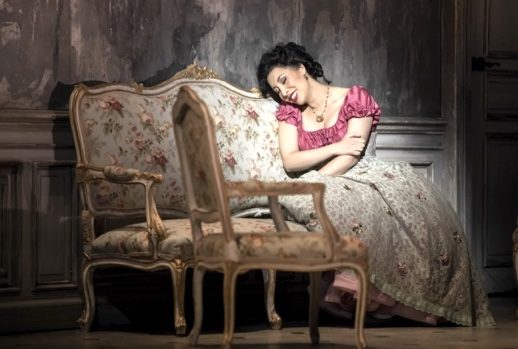

“Sheer vocal beauty”: Nicole Cabell as Violetta.
“Another lousy Traviata” is the meme du jour. Minnesota Opera’s stab at boosting revenue with extra performances of something surefire never caught fire.
Director Louise Muller boasts an impressive resume that suggests a talent AWOL from this pallid “offend no one” quasi-traditional non-starter.
If you want to do “minimal,” be striking and expressive. Think Willy Decker. The costumes (Isabella Bywater) suggested a place and time sans the period-defining luxe. The set suggested a Paris haute monde where the walls were papered in mold.
The Personenregie was weighted toward standing stage center, facing the audience, and using stock gestures—not semiotic Robert Wilson gestures; hackneyed “operatic” gestures.
Nicole Cabell’s Violetta was a sweet relief. She produced even beauty of tone from bottom to top. A lyric soprano, she wisely skipped the optional Eb in “Sempre libera,” and sold it with sheer vocal beauty.
The Ordway Theater is similar in size to Munich’s National Theater (minus the acoustic) and she had no difficulty being heard above the orchestra and chorus, while spinning limpid and affecting phrases in intimate moments.
The same could not be said of Jesús León’s Alfredo. He was unpersuasive and wooden. His clarion top notes were only reached with palpable difficulty but with a ringing finish. When in gear, he was in the JDF fach, tremulously appealing; too often, he seemed stressed.
The surprise standout was Youngjoo An. Physically and vocally he is cut from the same cloth as Kwangchul Youn—powerful, compact, and resonant. He received a wildly spontaneous and enthusiastic ovation at curtain calls; the audience got him.
His Germont père was a good guy, a misguided father driven by concern for his children, devastated by the tragedy he unleashed. Despite the directorial stodginess, Youngjoo delivered a nuanced and musical portrayal.
Conductor Christopher Franklin needs to rethink his Verdi. His tempi, brisk to a fault, were more appropriate to H.I.P. Handel. Except for a surprisingly lilting “Di provenza” and a pensive “Addio del passato,” he left no space for Verdi’s long lines to breathe. At such high speed the orchestra, chorus, and soloists often veered out of synch.
The Kentucky Derby approach didn’t work. I wondered if he was advised to wrap up by 10pm because that’s when the audience gets fidgety.
That the Minnesota Orchestra is of any quality at all is due to Music Director Osmo Vanska, who publicly defied a craven Board intent on slashing the size, schedule, and salaries of the orchestra, leaving little more than a show band.
With New York and European engagements on the calendar and recording sessions in the works, Vanska announced he would resign unless the Board ended the lock-out of musicians and negotiated in good faith. In the end the Board lost, members as well as issues.
Vanska did not conduct this Requiem. Edward Gardner did. I had not previously heard of him but his CV is impressive and his Requiem was beautifully realized, from an opening so hushed it forced the audience to stop fidgeting, to bone-shattering Dies irae, rex tremendae, and every shade in between.
The acoustic of Orchestra Hall is overly bright so the brass easily overwhelms the soundscape, but Gardner balanced his forces with a precise ear and the players responded with lyricism and virtuosity.
Ironically the Requiem delivered all the nuance, style and Verdian line that Traviata lacked. Gardner’s reading was not as sublimely spiritual as Giulini’s, but from the opening pianissimo to the a capella chorus to the vocal solos and ensembles, he found the right tempo and attitude for the music to soar.
The solo quartet, Ailyn Pérez, Elizabeth Deshong, Rene Barbera and Eric Owens, were nicely matched and superbly supported by the formidable Minnesota Chorale at peak pitch.
Pérez’s look was subdued glamor. Her lovely lyric voice was firing on all cylinders, from top to bottom. In the big tutti she was buried in the sound, but so was everyone else. In the Recordare she wrapped Deshong in velvet. In the Libera me she commanded power and hushed intensity.
Deshong was of two voices. Her barrel-organ lower register was plush, with silky legato and captivating tone. The upper register was less convincing, a seemingly different instrument lacking the beauty and effortlessness of her lower register. Nonetheless she meshed well in the ensembles, and contributed both drama and dignity.
Magari. If only Barbera had been Alfredo in Traviata! His singing was refined, with a clarion top, stylish and dramatic without being overtly theatrical. The Ingemisco was notable for its legato, his delicately shaded dynamics, and thrillingly crafted crescendos. I look forward to hearing him again.
Owens was magisterial, intense, and humble. No showboat he. His Mors stupebit was artfully understated, his Confutatis moving, his approach throughout restrained. The acoustic was neither kind nor responsive to his voice in the big moments; he shone best in expressive, introspective passages.
Gardner conjured a magnificent edifice on a foundation of sublime melodic invention. He avoided treating it as a concert opera and conjured instead a sublimation of the operatic in the liturgical.
Photo: Dan Norman

























Comments